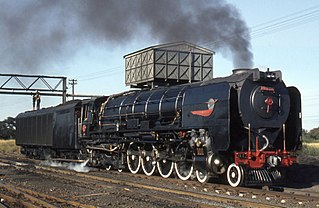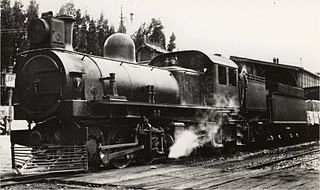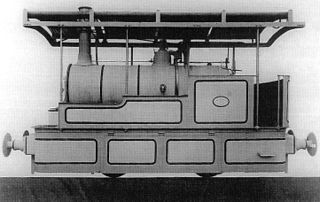
A steam engine is a heat engine that performs mechanical work using steam as its working fluid. The steam engine uses the force produced by steam pressure to push a piston back and forth inside a cylinder. This pushing force can be transformed, by a connecting rod and crank, into rotational force for work. The term "steam engine" is generally applied only to reciprocating engines as just described, not to the steam turbine. Steam engines are external combustion engines, where the working fluid is separated from the combustion products. The ideal thermodynamic cycle used to analyze this process is called the Rankine cycle. In general usage, the term steam engine can refer to either complete steam plants, such as railway steam locomotives and portable engines, or may refer to the piston or turbine machinery alone, as in the beam engine and stationary steam engine.

A steam locomotive is a locomotive that provides the force to move itself and other vehicles by means of the expansion of steam. It is fuelled by burning combustible material to heat water in the locomotive's boiler to the point where it becomes gaseous and its volume increases 1,700 times. Functionally, it is a steam engine on wheels.

A Fairlie locomotive is a type of articulated steam locomotive that has the driving wheels on bogies. The locomotive may be double-ended or single ended. Fairlies are most famously associated with the Ffestiniog Railway in North Wales.

A tank locomotive or tank engine is a steam locomotive that carries its water in one or more on-board water tanks, instead of a more traditional tender. Most tank engines also have bunkers to hold fuel; in a tender-tank locomotive a tender holds some or all of the fuel, and may hold some water also.

A tender or coal-car is a special rail vehicle hauled by a steam locomotive containing its fuel and water. Steam locomotives consume large quantities of water compared to the quantity of fuel, so their tenders are necessary to keep them running over long distances. A locomotive that pulls a tender is called a tender locomotive. Locomotives that do not have tenders and carry all their fuel and water on board the locomotive itself are called tank locomotives or tank engines.

A fire-tube boiler is a type of boiler invented in 1828 by Mark Seguin, in which hot gases pass from a fire through one or more tubes running through a sealed container of water. The heat of the gases is transferred through the walls of the tubes by thermal conduction, heating the water and ultimately creating steam.

Beyer, Peacock and Company was an English railway locomotive manufacturer with a factory in Openshaw, Manchester. Founded by Charles Beyer, Richard Peacock and Henry Robertson, it traded from 1854 until 1966. The company exported locomotives, and machine tools to service them, throughout the world.

A steam turbine locomotive was a steam locomotive which transmitted steam power to the wheels via a steam turbine. Numerous attempts at this type of locomotive were made, mostly without success. In the 1930s this type of locomotive was seen as a way both to revitalize steam power and challenge the diesel locomotives then being introduced.

A thermal power station is a type of power station in which heat energy is converted to electrical energy. In a steam-generating cycle heat is used to boil water in a large pressure vessel to produce high-pressure steam, which drives a steam turbine connected to an electrical generator. The low-pressure exhaust from the turbine enters a steam condenser where it is cooled to produce hot condensate which is recycled to the heating process to generate more high pressure steam. This is known as a Rankine cycle.

A surface condenser is a water-cooled shell and tube heat exchanger installed to condense exhaust steam from a steam turbine in thermal power stations. These condensers are heat exchangers which convert steam from its gaseous to its liquid state at a pressure below atmospheric pressure. Where cooling water is in short supply, an air-cooled condenser is often used. An air-cooled condenser is however, significantly more expensive and cannot achieve as low a steam turbine exhaust pressure as a water-cooled surface condenser.

The steam-electric power station is a power station in which the electric generator is steam driven. Water is heated, turns into steam and spins a steam turbine which drives an electrical generator. After it passes through the turbine, the steam is condensed in a condenser. The greatest variation in the design of steam-electric power plants is due to the different fuel sources.

A condensate pump is a specific type of pump used to pump the condensate (water) produced in an HVAC, refrigeration, condensing boiler furnace, or steam system.

The Franco–Crosti boiler is a type of boiler used for steam locomotives. It was designed in the 1930s by Attilio Franco and Dr Piero Crosti. The main difference between it and conventional feedwater heaters widely used on the continent is that the Franco-Crosti boiler uses both exhaust steam and exhaust gases from the firebox. Conventional feedwater heaters only use exhaust steam.

A tram engine is a steam locomotive specially built, or modified, to run on a street, or roadside, tramway track.
A deaerating feed tank (DFT), often found in steam plants that propel ships, is located after the main condensate pump and before the main feed booster pump. It has these three purposes:
- Remove dissolved oxygen (“air”) from the condensate
- Pre-heat the feedwater
- Provide a storage/surge volume

The South African Railways Class 25 4-8-4 of 1953 was a condensing steam locomotive.

The Great Northern Railway (GNR) Class L1 was a 0-8-2T side tank steam locomotive designed by Henry Ivatt. It was originally designed for suburban passenger traffic on the Metropolitan City Lines.

The South African Railways Class KM 0-6-0+0-6-0 of 1904 was an articulated steam locomotive from the pre-Union era in Transvaal Colony.

The Cape Copper Mining Company 0-4-0WT Condenser of 1886 was a South African steam locomotive from the pre-Union era in the Cape of Good Hope.

The South African type CZ tender was a condensing steam locomotive tender.






















